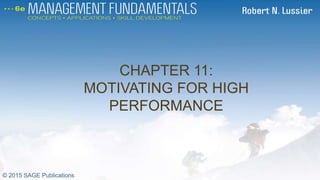
11 motivating for high performance
- 1. CHAPTER 11: MOTIVATING FOR HIGH PERFORMANCE CH 11 © 2015 SAGE Publications
- 2. Motivation • The internal process leading to behavior to satisfy needs • The primary reason people do what they do is to meet their needs or wants
- 3. The Role of Expectations In Motivation And Performance • The expectations of the manager can effect the performance of the employee. • Managerial treatment of an employee is a major factor in how employees performed.
- 4. How Motivation Affects Behavior • The level of performance is determined by three interdependent factors: • Ability • Motivation • Resources
- 5. Performance Formula • Performance formula: • Performance = Ability x Motivation x Resources • Ability and motivation are driving forces of behavior to create the level of performance • The key to success: • What do you like to do? • What are you good at doing? • Do you have the resources to achieve your goals?
- 6. Content Motivation Theories • Focus on identifying people’s needs in order to understand what motivates them • Needs Hierarchy • ERG Theory • Two-Factor Theory • Manifest Needs Theory
- 8. Needs Hierarchy Theory • Three major assumptions: • Only unmet needs motivate • People’s needs are arranged in order of importance (hierarchy), going from basic needs to more complex needs • People will not be motivated to satisfy a higher-level need unless the lower-level need(s) has been satisfied
- 9. Needs Hierarchy Theory • Five classifications of needs:
- 10. ERG Theory • Reorganizes Maslow’s needs hierarchy into three levels of needs: • Existence: physiological and safety needs • Relatedness: social needs • Growth: esteem and self-actualization needs • Maintains the higher- and lower- order needs • Also maintains that unsatisfied needs motivate individuals
- 11. Needs Hierarchy vs ERG Theory Self-Actualization Esteem Social Safety Physiological Growth Relatedness Existence Lower-level needs Higher-level needs
- 12. Two-Factor Theory (Herzberg) • The two-factor theory proposes that employees are motivated by motivators rather than by maintenance factors. • Maintenance factors (extrinsic): • lower level needs because the motivation comes from outside the job • Motivators (intrinsic): • higher level needs in which the motivation comes from the work itself
- 13. Two-Factor Theory • Providing maintenance factors keeps people from being dissatisfied, but does not motivate • Organizations need to ensure that employees are not dissatisfied with maintenance factors and focus on motivating them through their jobs • Employees are more motivated when they feel they are doing meaningful work
- 14. Acquired Needs Theory • Proposes that employees are motivated by their needs for achievement, power, and affiliation. • It is also called learned needs and three needs theory because of three needs: • The Need for Achievement • The Need for Power • The Need for Affiliation
- 15. Acquired Needs Theory • The Acquired Needs Theory holds that needs are based on personality and are developed and learned as people interact with the environment. • Managers tend to have a high need for power, followed by a high need for achievement, and a low need for affiliation.
- 16. Four Content Motivation Theories
- 17. Process Motivation Theories • Attempt to understand how and why people are motivated • Expectancy Theory • Equity Theory
- 18. The Motivation Process and the Motivation Theories
- 19. Expectancy Theory (Vroom) • Motivation = Expectancy x Valence • Expectancy: Perception of one’s ability to accomplish an objective • The higher one’s expectancy, the better the motivation • Valence: the value a person places on the outcome or reward • The higher the value (importance) of the outcome or reward, the better the motivation
- 20. Expectancy Theory • Clearly define objectives and the performance needed to achieve them • Tie performance to rewards • Be sure rewards have value to employees • Gain trust from employees
- 21. Equity Theory (Adam) • People compare their inputs and outputs to that of relevant others • Equitably Rewarded • Under Rewarded • Over Rewarded • Employees must perceive that they are being treated fairly, relative to others
- 22. Reinforcement Theory (Skinner) Stimulus Response Consequences (Behavior / Performance) (Reinforcement / Positive or Negative) • Behavior can be controlled through the use of rewards • Behavior is learned through experiences of positive and negative consequences
- 23. Types of Reinforcement • Positive Reinforcement • Generally works better than punishment, especially when training employees • Avoidance reinforcement • Also called negative reinforcement, used to encourage continued desirable behavior
- 24. • Punishment • Involves the actual use of a negative consequence to decrease undesirable behavior • Extinction: • Attempt to reduce or eliminate a behavior withholding reinforcement when an undesirable behavior occurs Types of Reinforcement
- 25. Schedules Of Reinforcement • Each and every desired behavior is reinforced • Real-time feedback to employees • Piece rate productivity reward for each unit produced • Reward is given based on the passage of time or output • Fixed interval schedule • Variable interval schedule • Fixed ratio schedule • Variable ratio schedule Continuous Reinforcement Intermittent Reinforcement
- 26. Rewards and Recognition Theory Reward Hierarchy of needs and ERG Lower level: Financial Upper level: Nonfinancial Two-factor theory Maintenance needs: Financial Motivators: Nonfinancial Acquired needs theory Varies Equity theory Equitable financial and nonfinancial Goal-setting theory Financial and nonfinancial Expectancy theory Dependent on what is valued Reinforcement theory Positive reward and negative punishment